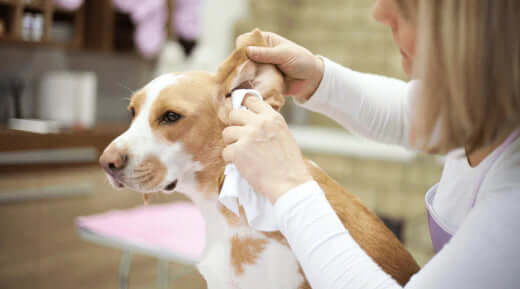The ears of our dogs come in a veritable plethora of shapes and sizes and their hearing is one of the most important senses they have. As such, keeping your dog's ears in as good a condition as possible is of paramount importance and being able to spot the signs of a problem or infection in their ears can be extremely useful in order to prevent an issue from being unnecessarily exacerbated.
In today's post, we will be exploring some of the most common ear problems that dogs suffer from, how to spot when your dog has a problem or infection in their ears, what to do when you have identified an ear issue and what the best ways of preventing these problems are.
Common Causes of Ear Infections in Dogs
There are several major causes of ear infections and issues in dogs. This means that identifying the exact problem can be difficult and a vet should always be consulted when you think your dog has an ear problem. Below we have listed a few of the most common causes of ear infections and discomfort to give you an idea of what might be going wrong when you identify a problem.
Dampness: If your dog's ears are damp it can cause i perfect growing environment for bacteria and yeast
Allergies: Allergies such as hayfever and food sensitivities can be the cause of ear issues
Wax Build-Up: A build-up of wax can affect how effectively your dog's ears are cleaned
Foreign Bodies: Anything in the ears that isn't supposed to be there can cause infection, common foreign objects include grass seeds and soil
Ear canal injuries: Any injury to the ear canal can lead to infection due to the open wounds
Excessive Cleaning/ Anxiety Behaviours: if your dog is obsessively cleaning their ears due to anxiety or stress, this can cause injury, contamination and infection
This list is not exhaustive and there can be many other causes of ear infections in our precious pooches. With this in mind, it is always best to consult a vet when you spot any signs of an ear infection in your dog.

Spotting the Signs Of Doggy Ear Issues
Although dogs can't communicate with us verbally, they will usually be telling you there is a problem if you know what to look out for. The common non-verbal signs that your dog has an issue in their ears are;
Head shaking
Excessive scratching and itching of the ears
Scabbing of the ears or the surrounding area
Unusual discharge
Bad smell
Sensitivity (pain)
What to do if Your Dog Has An Ear Problem
As we have said above if you notice the signs of an ear infection in your dog the only real course of sensible action is to consult your vet at the nearest possible convenience. This is due to the sheer amount of possible causes of ear infections and issues in dogs, and the possible problems caused by treating something that has been misdiagnosed. Most doggy ear infections are treated with regular cleaning and a course of medication such as antibiotic ear drops. However, we cannot stress enough that you should never treat an ear infection without professional advice and guidance.

Preventing Ear Problems in Your Dogs
At The Pets Larder, we always say that prevention is better than having to go through the rigamarole of diagnosis and treatment. Although ear infections cannot be completely prevented as your dogs go through their lives enjoying the outdoors and being a dog, there are a few things we can do to make sure they stand the best chance of avoiding these uncomfortable infections.
Our number one tip is to make sure that you keep your dog’s ears dry after swimming, bathing or in particularly heavy rain, as excess moisture is often the cause of ear infections. Keeping your dog's ears clean is also a great way to prevent ear infections, although over-cleaning can also lead to issues. Familiarise yourself with what your dog’s ears look like when they are healthy, this should be pink, odourless and free of dirt and inflammation, and only clean when you notice anything outside of this normal state.
For a full breakdown of how to clean your dog's ears, what to use and how to keep your dog calm during the process, check out the article below from the American Kennel Club.
How to Clean a Dog’s Ears - American Kennel Club>
If you are at all unsure about how to clean your dog's ears, are afraid of doing it incorrectly or are unsure about whether they need to be cleaned at all, it is always best to consult a professional.















